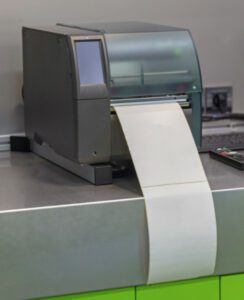Table of Contents:
Most of you associate Botland with 3D printing.
In fact, it’s one of our biggest passions, and we’re not just talking about FFF/FDM printing.
Today something seems to be much less commonly associated – let’s see what thermal printers are.
Thermal printing - what is it?
Thermal printing is a technique in which an image is printed on thermal paper using heat.
It is considered a digital printing process.
In thermal printing, heat is supplied by a controlled print head.
On the other side is thermal paper, which has a kind of heat-sensitive coating.
Such a duo allows printing in this novel method.
There are two methods of thermal printing direct thermal printing and thermal transfer printing, or thermal transfer printing – it is because of the English nomenclature of direct thermal printing and thermal transfer printing that the abbreviations DTP and TTP are encountered.
In direct thermal printing, heat from the print head is applied directly to the sheet.
This causes a chemical reaction in a special thermosensitive laminate layer, and physically changes the color of the paper to black.
Modern thermal paper is much more resistant to environmental influences, so the color will remain fresh for several years.
Thermal transfer printing, on the other hand, uses colored film or thermal transfer foil to achieve printing on paper.
The print head is equipped with hundreds of small heating elements that can be activated by computer.
The film runs between the print head and the paper and is melted by the print head, where the heating elements are activated.
The smooth surface of the film produces a precise and sharp print with a slight sheen.
The advantage of the thermal transfer system is an even longer print life compared to thermal printing.
Thermal printers and thermal paper - how do they work?
We already know that thermal paper is the main image carrier.
It is a specially coated paper that changes color in response to heat.
The thermal head is the main component that generates this heat, which is needed to develop the image on the paper.
It consists of many small heating elements that are electronically controlled to create a point-by-point image.
The paper roll holds the thermal paper and drives it through the printer mechanism.
The control electronics are responsible for controlling the thermal head and other printer components such as the paper sensor and interfaces for communication.
What does the process look like?
Printing data is sent to the printer via USB, Bluetooth or WiFi. The activated thermal head generates heat on selected areas of the thermal paper.
The thermal layer on the paper reacts and changes color so that an image or text can be produced.
A roll of paper takes care of moving the material under the thermal head.
The process itself is usually fast and quiet, with the not insignificant fact that it does not require traditional inks or toners.
The thermal printing method is therefore somewhat similar to burning, and thermal printers are considered relatively reliable thanks to their simplicity and lack of moving mechanical parts.
The thermal paper itself is impregnated with a dye mixture.
This can be a fluorine dye or loctadecylphosphonic acid used in the chemical industry to protect materials from oxidation and reduce surface tension.
When the matrix is heated above its melting point, the dye then reacts with the acid and goes into a colored form.
A related concept worth remembering here is thermochromism – the property of a substance to change color when exposed to a change in temperature.
Children are familiar with it – although they tend to remember little of it at the age when they interact with it – from milk bottles signaling with color the serving temperature, and adults from the so-called ideal temperature of chilled beer.
Thermal inkjet printing
Thermal printers, which due to the nature of the industry must print directly on product packaging, also use inkjet printing systems.
Their main advantage is that they can print on various surfaces such as paper, cardboard packaging, synthetic materials and metal surfaces.
Inkjet printing is used for pharmaceutical, cosmetic and food packaging, as well as postal services.
Thermal printers powered by inkjet printing systems use ink cartridges with multiple small chambers that can be heated by an electrical pulse.
The heat creates a small vapor bubble that pushes the ink through the nozzle.
The tension of the bubble and the surface tension of the ink droplet cause the ink to retract within a fraction of a second.
In this way, precise and high-quality printouts of text, barcodes or informative graphics in the form of bitmap or the increasingly popular QR codes can be achieved.
Another combination of thermal printing and inkjet technology is the so-called piezoelectric inkjet process or piezo inkjet printing.
In this case, the walls of the chamber are heated by an electrical impulse, so that they expand under the heat.
Ink is squeezed out of the nozzle onto the object.
When the electric pulse stops, the walls return to their original position.
A vacuum is created in the chamber, drawing the rest of the ink, which was not used for printing, back into the cartridge.
Thermal receipt printers
We’re all familiar with them.
Designed to print receipts and other sales documents, they are ubiquitous in stores and restaurants.
Thermal receipt printers for bills often differ in size from typical thermal printers used for labels or tickets.
They can be equipped with an automatic slicing mechanism, allowing the bill to be cut off precisely after printing.
While printing speed is important for all printer users, thermal receipt printers are usually specifically optimized for fast printing of short receipts, which is crucial in a retail environment where customer wait times must be minimal.
How useful was this post?
Click on a star to rate it!
Average rating 0 / 5. Vote count: 0
No votes so far! Be the first to rate this post.




















